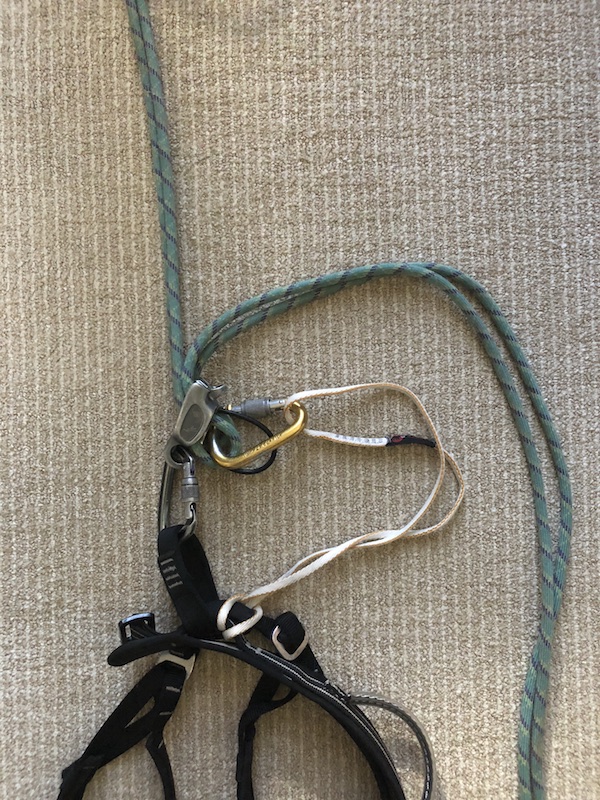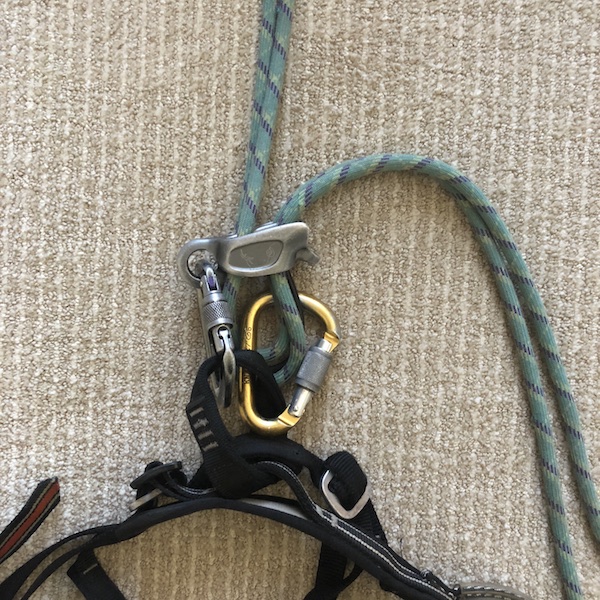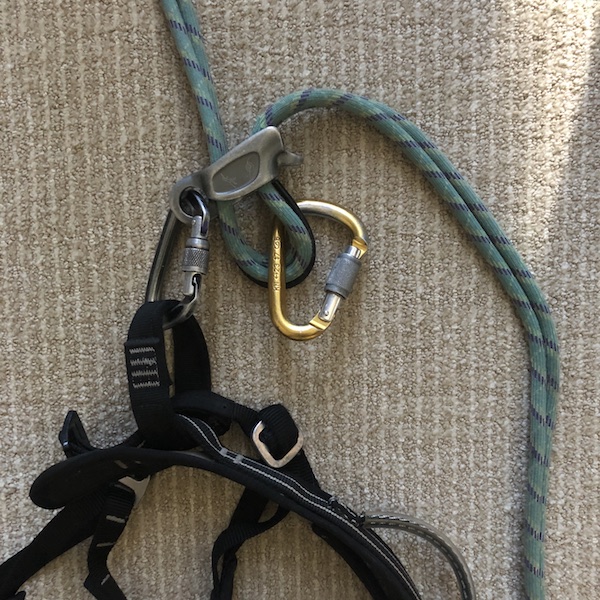Transformers! Your ATC belay device is also an ascender
Note - This post discusses techniques and methods used in vertical rope work. If you do them wrong, you could die. Always practice vertical rope techniques under the supervision of an experienced climber, and ideally in a progression: from flat ground, to staircase, to vertical close to the ground before you ever try them in a real climbing situation.
First off, a few disclaimers and cautionary notes . . .
Using a belay device in this manner is not explicitly approved by any manufacturer, as far as I know. Alpinesavvy offers ideas and information, not advice. Use this at your own risk. Instruction from a qualified professional is highly recommended when learning any new belay technique.
This technique can FAIL if you use a skinny rope and a large belay device!
I was easily able to put this into failure mode with a single strand rappel using an old style Black Diamond ATC Guide, and an 8 mm rope. Under even a small load, the rope strands can become inverted. This causes them to either jam together and you can't move the rope at all, or even worse, the strands become reversed, and you will fall / slide under load. Be sure and test this under a controlled environment with your preferred rope and belay device before you ever try it for real! (This is why you should NEVER use a device like this to rope solo.)
If using a skinny rope, be extra careful! Matching your ropes to the proper size belay device is always important, especially in this case. Consider using a device such as the Black Diamond ATC Alpine Guide, specifically made for smaller diameter ropes. You have been warned, be careful!
DMM Pivot belay device
Auto locking plaquette-style belay devices (such as the DMM Pivot, Black Diamond ATC Guide and Petzl Reverso) have become pretty much standard gear. The auto locking feature when belaying your second directly off the anchor has another nifty capability: rope ascender.
Now, you don’t want to use this when you head up a big wall climb, because it does add extra friction and it’s not quite as secure as a dedicated ascending system. But, for improvised rope climbing, such as in a rescue scenario, or if you find you need to ascend a rappel rope for some reason, this is a pretty cool trick.
A few notes . . .
Doing this is WAY better than the old school method of ascending a rope with two prusik loops!
The effectiveness of this system, and the ease that you can ascend, greatly depends on the type of belay device you are using, and the rope diameter, how old/stiff the rope sheath is, and some other variables. Generally, if you have a newer smaller diameter rope with a smoother sheath, this is going to be easier. If you have a newer style belay device made for smaller diameter ropes, and and try this with a stiff sheath 10mm rope, you will have a L O T of friction and hassle pulling the rope through the device.
Practice, practice, practice in a controlled environment before you ever try this in the real world.
If you’re on lower angle terrain, you might just be able to step up on the rock and pull slack through your device. If it's steeper, you'll probably need to rig some kind of a step for your foot, which I cover in this tip.
There are two possible scenarios where you can set this up.
Starting from a ledge or flat ground or otherwise good stance
When you’re already on rappel
Let's look at each one.
Method 1 - Rigging to ascend from a ledge or flat ground
Let’s start with the easiest set up, and assume you’re on the ground or a ledge and have a rope you need to climb. This rope can be a single strand or a double strand. (Hopefully this is obvious, but this rope needs to be fixed in some way at the top anchor, either directly tied, or looped through an anchor point like a standard rappel. )
You simply rig your belay device just like you would to belay up your follower directly off the anchor, and clip the “anchor” carabiner to your belay loop. One locking carabiner in the “ear”, which you would clip to the anchor master point (here, the black one), and one locking carabiner blocking the rope the rope (here, the yellow one).
(Note: this system works a bit better if the rope blocking carabiner is round metal stock, rather than some fancy weight shaving I-beam type construction. The rope slides more easily and there’s a bit less friction on the rounded metal. If you have one, use it, if you don’t, no biggie.)
Standard set up, just like you would for a direct belay from the anchor (black carabiner would clip to masterpoint, yellow carabiner blocks the rope, the strand to the “climber” is always on the top.)
Now, instead of clipping the black carabiner on the anchor, you simply clip it onto your belay loop. Now, if you sit back in your harness, the rope should lock off. Slick!
Method 2 - Rigging to ascend while on rappel
Hopefully this won’t happen very often, but sometimes when rappelling, you need to go back up the rope. Maybe you missed the anchors, or maybe the rope got stuck above you, and you were careless and went below it without untangling the mess. Whatever, it doesn’t really matter, you were rapping down and now you need to climb up. Here’s how to do it.
There’s two different ways this can be rigged. It depends on whether you are rappelling from an extended rappel or from your belay loop . An extended rappel is easier and safer; lots more on extended rappels at this Tip.
Let’s look at each one.
First off, whenever you’re doing any shenanigans like this way off the deck, tie a hard backup “aka “catastrophe knot”) in the rope below you. This is an overhand on a bight in both strands, clipped to your belay loop. This is insurance; if you screw up any part of the next couple steps, you’re not going to fall to the ground. So do this first. If you were rapping with an auto block, going hands-free to do this is easy. If not, use the old-school Crafty Rope Trick (CRT) of wrapping the rope a few times around your leg to go hands free.
“Catastrophe knot” - Overhand on a bight in both strands, clipped back to your belay loop with a locker.
Note: Both these methods require you unweight your rappel device for a moment. Hopefully you can find some kind of a stance where you can temporarily unweight the rope. If you can’t do this, you’ll have to get creative. Add a short prusik plus a foot loop and standing in it, or use the Crafty Rope Trick (CRT) of wrapping a few loops of rope around your foot and standing up, temporarily unweighting your rappel device.
Note: For clarity, the catastrophe knot backup is not shown in the following photos.
A - Rappelling from an extended rappel (easier and safer method)
An extended rappel makes this method safer, because you do not need to unclip your rappel carabiner as described below in method B. When you do this for the first time, you might actually amaze yourself, because it’s so fast and easy, it almost seems like a magic trick.
The set up shown below, with one single runner, is one of various ways to rig an extended rappel. The extended rappel is covered in depth here.
(For clarity, this photo doesn’t show an auto block third hand backup below the rappel device. If you only have a short way to ascend, you can leave it on. For a longer climb back up the rope, it's probably better to take it off, as shown in the video below. )
1 - Clip a locking carabiner into the “ear” on your rappel device.
2 - Unweight your device using one of the methods mentioned just above, and clip the “ear” onto your belay loop. Note the gold carabiner and yellow rap extension sling stay attached the whole time.
Sweetness, you’re ready to ascend!
Your extension gives you enough slack for the blocking carabiner to properly work. Nice! One more reason to use an extended rappel.
Bonus: one more cool thing about this method is that if you want to transition back into rappel, all you do is reverse the process. Simply unclip the black carabiner from your belay loop and you are back into rappelling position.
Here's a nice instructional video that walks you through this step-by-step.
Here’s a video from AMGA Certified Rock Guide Cody Bradford showing how to do this.
While sadly Cody is no longer with us, his Instagram continues to stay up and is a great source of tips like this, check it out.
B - Rappelling from your belay loop
1 - Clip a locking carabiner to the “ear” of your rappel device.
2 - Unweight your device using one of the methods mentioned just above, and clip the “ear” onto your belay loop.
3 - Carefully, and I mean VERY carefully, unclip your rappel carabiner (here, the gold one) from your belay loop, WITHOUT unclipping the rope. If you unclip the rope at this moment, you are completely unattached to your rappel device, so practice this on the ground and do it VERY carefully!
You DID tie that catastrophe knot, RIGHT? This step is DANGEROUS! Pay ATTENTION!
This sketchy and awkward step is NOT required if you're using an extended rappel, as shown above. (Take the hint, use an extended rappel . . .)
When you're done, it should look like the photo below.
You now have your rappel device in the ascending position.









